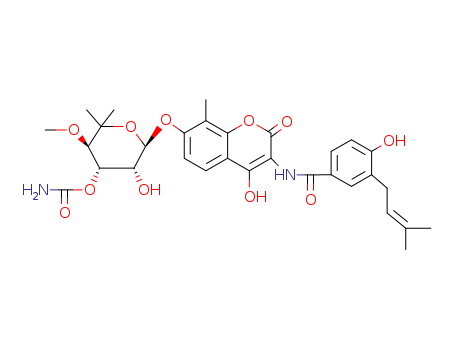10.1021/ol702655c
The study focused on the asymmetric synthesis of L-(+)-Noviose, a sugar component of the antibiotics novobiocin and coumarin. The goal of the study was to develop alternative and rapid methods to synthesize L-(+)-Noviose from readily available non-carbohydrate starting materials while taking advantage of stoichiometric and asymmetric processes. The researchers achieved this goal through two independent methods, one involving six steps with an overall yield of 27% and the other involving nine steps with an overall yield of 20%. A variety of chemicals were used in the synthesis, including 2,2-dimethyl-1,3-cyclopentanedione, (S)-B-Me-oxaborane ((S)-B-Me-CBS), BH3 N,N-dimethylbenzene complex (DEANB), methyl ethers, Sc(OTf)3, Saegusa oxidation, Pd(OAc)2, trimethylsilyl ketene intermediates, ene palladium, NaH, Grubbs second generation catalyst, DIBALH, water, and other chemicals for non-catalyzed xylene reactions. The study conclusions highlight the successful development of two efficient synthetic routes to L-(+)-Noviose, suitable for the synthesis of unnatural analogs, without the need for protecting groups, and utilizing commercially available reagents such as Corey's CBS and Brown's reagent.
10.1021/acsinfecdis.1c00100
This research endeavored to develop novel small-molecule therapeutics targeting multidrug efflux pumps, which are a significant factor in antibiotic resistance among Gram-negative bacteria. The team focused on modifying the cinnamoyl group of a diaminoquinoline acrylamide, NSC-33353, known to inhibit the AcrAB?TolC efflux pump in Escherichia coli. They synthesized a series of cinnamoyl- and naphthyl-derived amides of the 4,6-diamino-2-methylquinoline scaffold. The cinnamoyl analogs showed strong binding to AcrA, potentiated the activities of antibiotics novobiocin and erythromycin, and inhibited efflux. However, they also demonstrated cytotoxicity. In contrast, naphthyl analogs, which had lower cytotoxicity, did not bind to AcrA but potentiated novobiocin, suggesting a shift in their mechanism of action possibly due to changes in their interaction with AcrB. The study concluded that chemical modifications can significantly alter the activity and mechanism of efflux pump inhibitors, providing valuable insights for developing new therapeutics to combat antibiotic resistance.




